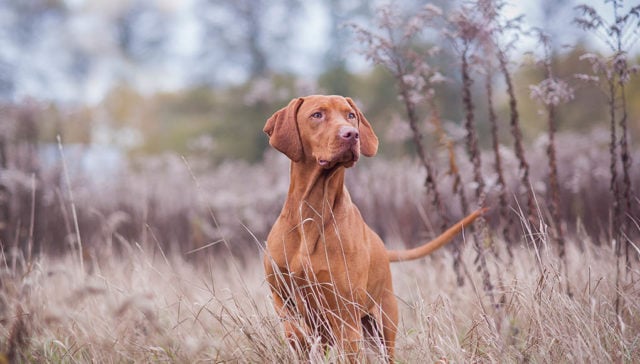
Table of Contents
Looking for a dog with style and grace? Well, let me introduce you to the Vizsla dog breed. The Americal Kennel Club calls this breed “lively, gentle-mannered, demonstrably affectionate, and sensitive.”
The Vizsla dog breed is a robust hunting dog that needs intense daily exercise and a lot of attention, too. So, if you're the type of person who's always away from a business trip, this might not be the dog for you.
And if you're looking to adopt a Vizsla puppy, you can go look for the best breeders in your area or rescue groups.
If Vizslas are confined way too long and have no companionship, it can lead to behavioral issues like hyperactivity and destructiveness. They are known to be notorious chewers when bored.
Also known as “Velcro Vizsla,” we all know most dogs are affectionate, but this hunting dog breed is very much attached and loyal to its person.
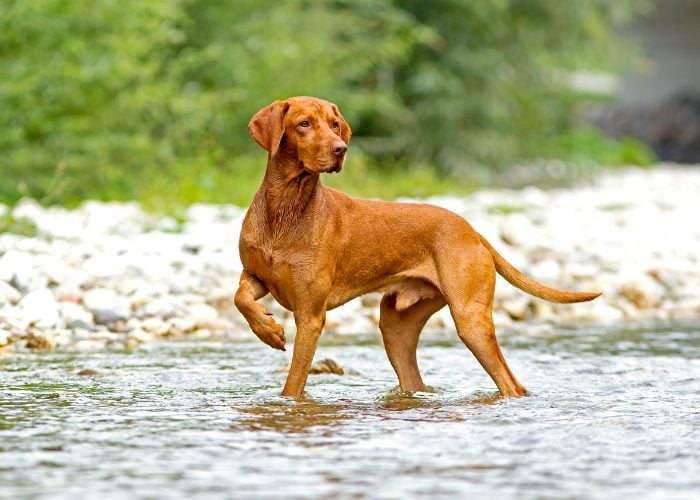
History of the Vizsla Dog Breed
Known as the Hungarian Hunters, with incredible speed and agility, meet the Vizslas.
Vizslas are known to be around us humans for quite a long time. Their existence is carved in stone in Carpathian regions as it shows a Magyar hunter, a falcon, and a Vizsla.
Vizsla's ancestor, Magyar Vizslas, was bred specifically for their hunting capabilities. Their keen sense of smell, retriever, and pointer features were the key to obtaining their hunting skills.
After centuries, Vizlas had Hungarian noblemen and only them. When the empire collapsed, the Magyar Vizslas were cross-bred with Weimaraner and German Short-Haired Pointer, resulting in the Vizslas we have today.
During the 19th century, Vizsla’s existence became endangered again. Fortunately, owners and breeders found ways to preserve this breed and continued breeding healthy Vizslas.
The word Vizsla translates to ‘pointer’ in Hungarian. Vizslas are reputable for their capabilities as pointer and retriever dogs.
This breed has cat-grooming tendencies. They excessively groom their coat frequently. They are known for having no odor.
Vizsla named Chartay was also the first American Kennel Club Triple Champion. They excelled and won in show, field, and obedience.
Vizsla is part of the sporting group. Vizslas are excellent working dogs as well. Their abundant energy and enthusiasm make them the perfect working companion, too.
This dog breed is known to work with search and rescue teams. Vizslas also worked as messenger dogs during World War II.
Physical Characteristics
Height and Weight
A male Vizsla dog breed's average height is 22 to 24 inches tall at the shoulder, while a female Vizsla is around 21 to 23 inches tall.
On the other hand, the average weight of a female Vizsla is 44-55 pounds, while males are much larger dogs weighing up to 65 pounds.
Coat
With various shades of solid golden rust, the Vizsla dog breed has a short and smooth coat. And thanks to their short and sleek coat, Vizslas are low-maintenance dogs when it comes to grooming.
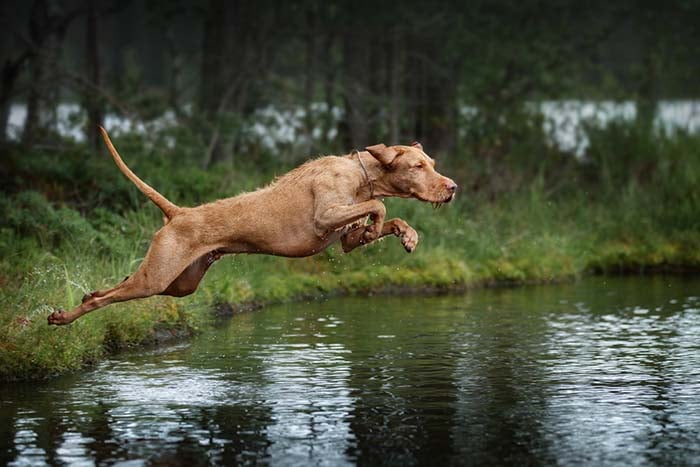
Temperament of a Vizsla
Vizslas are the perfect companion dog. This breed will help you stay active or even chill at home. They are extremely devoted to their family or owners.
Vizsla is incredibly affectionate towards their family or companion. They love to relax with their owners.
In fact, they stay close to their owners, literally seeing their paws or heads at your feet. Going somewhere? Vizslas are your very own self-willed escorts.
They are best inside their homes rather than left outside. Vizslas thrive on companionship and may be anxious if left alone or separated for long periods.
Vizsla may be gentle, but they are unduly energetic. They also go well with children but do supervise Vizslas around children. Little kids may trigger their sudden bolts of excitement.
They are very open towards strangers as well. Vizslas don’t discriminate quickly. They will welcome anyone unless the stranger displays a threat.
Vizsla is incredibly adaptable. They are not as vigilant, territorial, or protective.
Vizsla is a sensitive dog. They appreciate those who treat them well and kindly. Especially during training, they respond better to positive reinforcements and praises.
They will be eager to please you and work with you, so training them should be gentle as well. They have an enormous amount of energy and may not know how to compress it. Just be patient, and they will show you great results.
It’s important to train and socialize Vizslas from a young age. During this stage, their mental and physical abilities can be challenged, but do go easy on them.
Remember to praise them and give them treats if they are successful. This will show better results.
RECOMMENDED: What is a Velcro Dog? Its Signs, Causes, and Solution
Living with a Vizsla
Vizslas are good with other dogs. They are very friendly towards other dogs, especially when they have been socialized at a young age.
Be careful with other dogs, though. Vizslas' energy may overwhelm the dogs around them.
They can also be around cats if they are introduced and exposed to cats at a young age. Unfortunately, it is highly advised not to have small pets around them as they may chase and hunt them down.
On the other hand, Vizslas may not be the best option for apartment living. They need to run, not just want but literally need it.
Vizslas are extreme balls of energy that would run and sprint around. If their exercise or training requirements are not met, expect a wild dog on the loose inside the house.
Vizslas are best living in big yards or the countryside. Their desire to run around anywhere at any moment will be satisfied.
They are also quite talkative. Vizslas don’t necessarily bark but they will attempt to make conversations with you.
Vizslas are not meant to be alone. They should be around their families. If the owner or family plans to leave for a while, it’s best to have them doggy sit by someone the dog already knows.
Vizslas are outdoor enthusiasts. They exceed in speed and agility, and the outdoors are the perfect place to express this energy.
Owners who are active physically are perfect for Vizslas. They may accompany their owners during their jogging or outdoor sports regimen.
A Vizsla thrives in warm seasons. Their coat is short-haired with no undercoat, so it may be difficult for them to handle cold seasons.
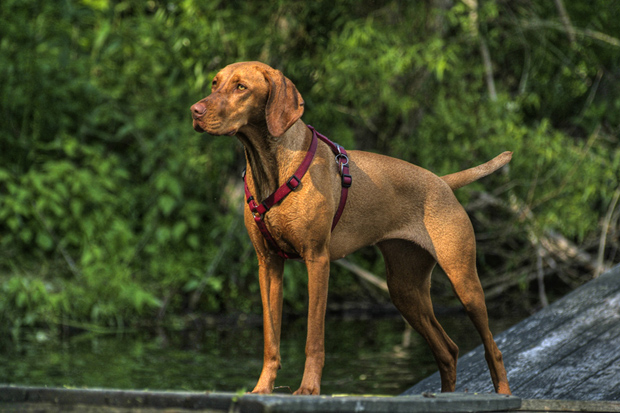
Vizla Dog Breed's Health
Vizslas are generally a healthy dog breed. However, just like any dog breed, there are certain health problems that they are prone to.
The list below doesn't mean your Vizsla will experience these health conditions. These are just health issues that you should be aware of if you're trying to adopt a Vizsla.
That's why adopting from a reputable breeder is crucial. A responsible breeder can provide health clearances that prove that the dog has been tested and cleared for specific types of health issues.
Ask them for health clearances from the Orthopedic Foundation for Animals for hips and thyroid problems, and the Canine Eye Registration Foundation to ensure that their eyes are normal.
Here are a few health problems that can affect a Vizsla:
Hip Dysplasia
Canine Hip Dysplasia is one of the most common hip problems in dogs. This is a heritable condition where the thighbone doesn't fit into the hip joint.
Since this is a hereditary problem, it all comes back to choosing the proper breeder. Dogs that are suffering from hip dysplasia should not be bred.
If you're planning to adopt a dog, ask for proof that the dog's parents have been tested and cleared for hip dysplasia.
It's important to monitor your pet because only some dogs can show signs of pain and lameness on one or both rear legs, but it is also common for dogs to not show any symptoms or discomfort.
When dogs get older, they are also prone to arthritis. It is best to have them X-rayed for hip dysplasia first at the Orthopedic Foundation for Animals.
Hip dysplasia, if not properly treated, can worsen over time. Avoid high-calorie diets and be careful with injuries from jumping or falling.
Epilepsy
Epilepsy in dogs is a disorder that can cause seizures. It is the most common neurological disorder in dogs. An estimated 0.75% of the dog population has been affected by epilepsy.
Unfortunately, there is still no cure for epilepsy. But it can be managed with medication. With proper care and management, your pup can still live a long and happy life.
Similar to hip dysplasia, this disorder can be inherited. Research thoroughly on the right breeder to make sure that your pup is free from this disease.
Progressive Retinal Atrophy
Progressive Retinal Atrophy, or PRA, is an eye condition in dogs that gradually leads to blindness. This severe eye condition is one of the hardest to spot due to a lack of symptoms.
It is your job to monitor your dog. Notice if they are tripping over things or bumping into walls or furniture that they don't usually bump into.
As soon as they generally display signs of poor eye vision, PRA might be the problem. It is best advised to rush your dog to the vet for further examinations.
Hypothyroidism
This is a common condition in dogs that can lead to unexplained weight gain, skin and coat issues, reduced energy levels, and even behavioral changes.
Hypothyroidism happens when your dog's thyroid is not producing the right amount of thyroid hormones to regulate its metabolism, causing it to slow down properly.
The common cause of Hypothyroidism in dogs is either lymphocytic thyroiditis or idiopathic atrophy of the thyroid gland.
Since this condition causes your dog's metabolism to slow down, a few signs of Hypothyroidism are:
- Obesity
- Lethargy (lack of energy)
- Thinning coat
- Dull looking fur
- High cholesterol
- Slow heart rate
- Lameness
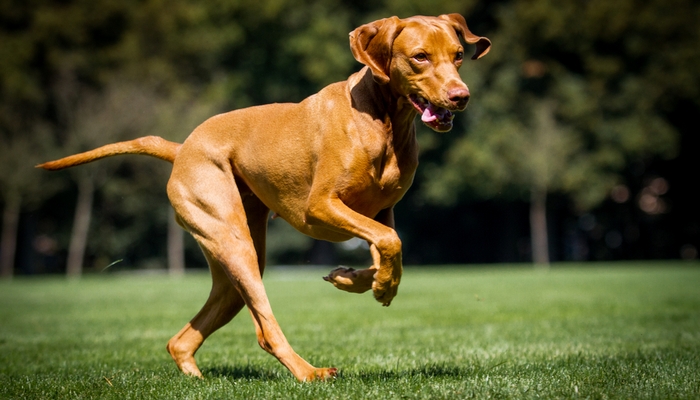
Caring for a Vizsla
Exercise
Since Vizslas are an active dog breed, they need at least 60 minutes of exercise per day. Vizslas are the perfect dog for people who love going on walks, jogging, or running.
These dogs enjoy loving the outdoors, playing fetch, and other dog sports. Exercise is the key to maintaining a happy and healthy relationship with a Vizsla.
If your Vizsla is just forced to stay at home without being able to exercise, they'll eventually become destructive and hard to handle.
As the dog owner, it is your responsibility to ensure that their excess energy is gone through play and exercise. You don't want to come home to your house all messy and destroyed, right?
Training
When it comes to training a Vizsla, remember that they respond well to positive reinforcement. Give treats and praise when they perform well.
Be consistent and considerate. You should never be harsh to your Viszla if you want them to thrive.
It is also recommended that you start their training while they are still a puppy. Training at a young age can give you the best results.
Diet
We all want our dogs to be healthy and happy. That's why it's best to buy high-quality dog foods for our best buds. The quality of food that you give matters more than you think.
High-quality dog foods can help your dog grow further and nourish them even more in the long run.
The recommended daily amount of food for Vizslas is 3 to 4 cups which is divided into two meals per day. However, just like with us humans, the quantity of food will depend on their age, body build, metabolism, and activity level.
Also, keep your Vizsla in good shape by measuring the quantity of food that you give them. Overweight or obese dogs have tendencies to develop health problems like diabetes.
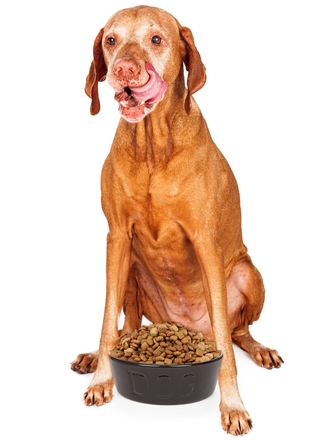
Commonly Asked Questions
Do Vizslas bark a lot?
Vizslas are very vocal dogs. So get ready for whines, moans, howls, and grunts, as these are their way of communicating. But do they excessively bark?
Generally, no, Vizslas are not excessive barkers. However, excessive barking in Vizslas usually means that they are unhappy or improperly trained.
Does Vizsla dog shed?
Vizslas are low to moderate shedders. They only need one or two brushes per week to keep them free of loose hair.
This dog breed also rarely needs bath time. They also do not have a strong dog odor.
How long do most Vizslas live?
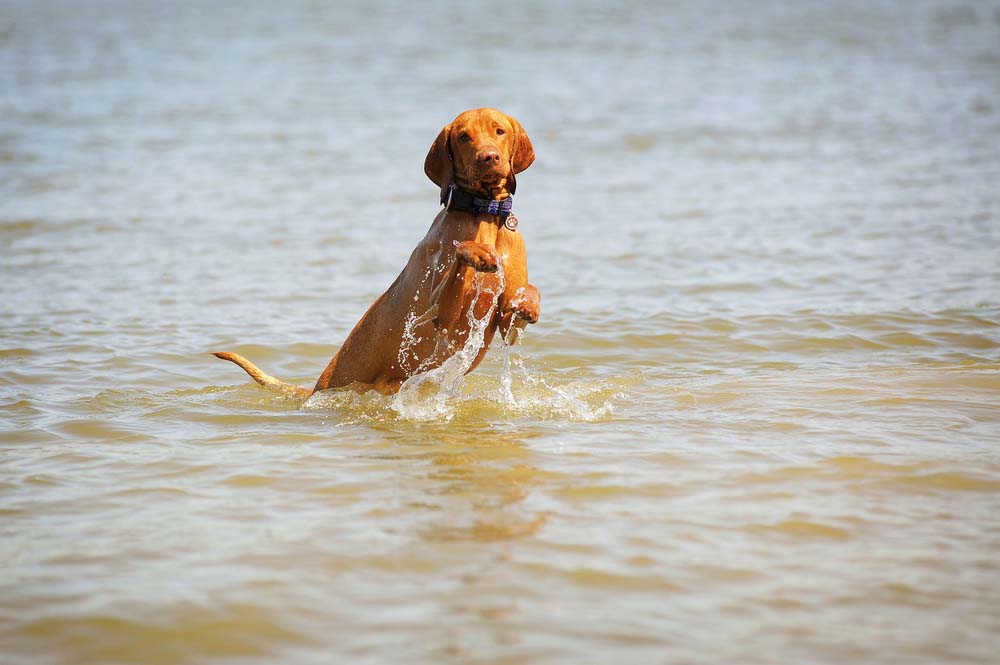
Vizsla Dog Breed Profile Summary
If I had to describe the Vizsla dog breed in three words, it would be smart, active, and loyal. These active dogs are great for people who love to play and jog.
Since these dogs are built for activities, make sure that they're getting enough exercise. If all that energy is stored, it can lead to behavioral issues.
The Vizsla dog breed can hunt, track, and do well in agility courses. They are also great as a family companion.
If you're looking to adopt a Vizsla Puppy, make sure to find a responsible breeder who gives you all the health clearance you need. In this way, you are ensured that you'll be getting one healthy pup.
But you can also look for rescue groups like Vizsla Canada Adoption and Vizsla Club of America Rescue.












